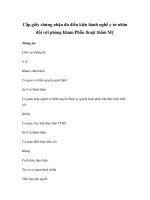Sách Phẩu thuật thẩm mỹ 2012
Bạn đang xem bản rút gọn của tài liệu. Xem và tải ngay bản đầy đủ của tài liệu tại đây (2.09 MB, 253 trang )
Plastic Surgery
Shehan Hettiaratchy
Matthew Griffiths • Farida Ali
Jon Simmons
(Editors)
Plastic Surgery
A Problem Based Approach
Editors
Shehan Hettiaratchy, M.A.
(Oxon), BM BCh, FRCS(Eng),
DM, FRCS(Plast)
Department of Plastic
and Reconstructive Surgery
Imperial College Healthcare
NHS Trust, London
UK
Farida Ali, MB ChB, M.Sc.,
FRCS (Plast)
Department of Plastic
and Reconstructive Surgery
St George’s Hospital
London, UK
Matthew Griffiths, MBBS, FRCS,
MD, FRCS (Plast)
Department of Plastic
and Reconstructive Surgery
Broomfield Hospital
Chelmsford, UK
Jon Simmons, B.Sc., MBBS,
MRCS, M.Sc. FRCS (Plast)
Department of Plastic
and Reconstructive Surgery
Imperial College Healthcare
NHS Trust, London
UK
ISBN 978-1-84882-115-6 e-ISBN 978-1-84882-116-3
DOI 10.1007/978-1-84882-116-3
Springer London Dordrecht Heidelberg New York
British Library Cataloguing in Publication Data
A catalogue record for this book is available from the British Library
Library of Congress Control Number: 2011933717
© Springer-Verlag London Limited 2012
Apart from any fair dealing for the purposes of research or private study, or criticism or
review, as permitted under the Copyright, Designs and Patents Act 1988, this publica-
tion may only be reproduced, stored or transmitted, in any form or by any means, with
the prior permission in writing of the publishers, or in the case of reprographic repro-
duction in accordance with the terms of licenses issued by the Copyright Licensing
Agency. Enquiries concerning reproduction outside those terms should be sent to the
publishers.
The use of registered names, trademarks, etc., in this publication does not imply, even
in the absence of a specific statement, that such names are exempt from the relevant
laws and regulations and therefore free for general use.
Product liability: The publisher can give no guarantee for information about drug dos-
age and application thereof contained in this book. In every individual case the respec-
tive user must check its accuracy by consulting other pharmaceutical literature.
Printed on acid-free paper
Springer is part of Springer Science+Business Media (www.springer.com)
v
Foreword
The surgical trainee is required to assimilate an ever increas-
ing amount of knowledge and for the plastic surgeon this
covers a wide area. Consequently, it can sometimes be diffi-
cult to maintain attention on the fundamentals of patient
assessment. This book aims to bring the focus back on the
patient by providing an algorithmic approach to taking a his-
tory, examination and formulating a management plan. This
refreshingly different clinical problem-based style makes it
easy to read. At the end of every chapter the authors provide
some key references for further reading.
The book should appeal to the early years trainee as well
as to those preparing for clinical examinations
vii
Preface
Plastic surgery is a big subject and the size of traditional text-
books reflects this. This book was conceived as something
different. Instead of a top-down, subject-by-subject approach,
we wanted a bottom-up approach, with the starting point
being a patient with a problem. The stimulus for this method
was lack of any decent texts for the clinical sections of the
professional exams in plastic surgery FRCS Plast in the UK,
boards in the USA and their equivalents in other parts of the
world). The chapters were written with the concept of a
patient sitting in front of the reader, as there would be in the
exam situation. However the same approach works when one
first sees a patient in the clinic. We aimed to provide the
reader with the structure and information necessary to be
successful in their careers. We have used our experience to
ensure the text is as succinct and relevant as possible. We
hope we have achieved this in some way and that this book
forms a useful adjunct to more traditional texts.
Many have contributed to the book and we would like to
thank them for their hard work and effort. SH would particu-
larly like to thank Jon Simmons for getting us across the fin-
ish line; it would not have happened without him and his
dogged determination. Finally, we would like to thank our
patients from whom we have learnt everything that is in this
book.
Shehan Hettiaratchy
Jon Simmons
ix
Acknowledgements
The Editors would specifically like to thank the following for
providing the artwork in this book:
Simon Mackey
Specialist Registrar, Plastic and Reconstructive Surgery
Pan-Thames Training Scheme
London, UK
xi
Contents
1 Abdominoplasty 1
Robert Caulfi eld and Shehan Hettiaratchy
2 Blepharoplasty 9
Robert Caulfi eld
3 Breast Reconstruction 17
Robert Caulfi eld and Matthew Griffi ths
4 Large Breasts/Reduction 25
Robert Caulfi eld and Matthew Griffi ths
5 Ptotic Breasts/Mastopexy 33
Robert Caulfi eld and Matthew Griffi ths
6 Burns Contracture 41
Farida Ali and Jon Simmons
7 Burns 47
Farida Ali, Abhilash Jain, and Jon Simmons
8 Cleft Lip and Palate 57
Ivo Gwanmesia, Matthew Griffi ths,
and Jon Simmons
9 Congenital Hand 65
Shehan Hettiaratchy and Jon Simmons
10 Craniosynostosis 73
Ivo Gwanmesia and Matthew Griffi ths
xii Contents
11 Dupuytren’s Disease 79
Shehan Hettiaratchy and Jon Simmons
12 Facial Palsy 87
Ivo Gwanmesia, Farida Ali, and Jon Simmons
13 Maxillofacial Trauma 93
Farida Ali, Ivo Gwanmesia, and Jon Simmons
14 Gynaecomastia 103
Robert Caulfi eld and Jon Simmons
15 Hand with Nerve Palsy 109
Shehan Hettiaratchy and Jon Simmons
16 Hand with Infl ammatory Arthropathy 117
Shehan Hettiaratchy, Abhilash Jain,
and Jon Simmons
17 Hypospadiat 125
Ivo Gwanmesia and Matthew Griffi ths
18 Lower Limb Trauma 131
Shehan Hettiaratchy, Abhilash Jain,
and Jon Simmons
19 Lump in the Neck 137
Farida Ali, Ivo Gwanmesia, and Jon Simmons
20 Complex Wounds: Pressure Sore 143
Jon Simmons and Matthew Griffi ths
21 Abnormal Ear 149
Ivo Gwanmesia, Matthew Griffi ths,
and Jon Simmons
22 Management of the Pigmented Lesion 157
Fiona Harper
xiii Contents
23 Aged Face: Facelifting 165
Shehan Hettiaratchy
24 Nerve Compression 175
Shehan Hettiaratchy, Abhilash Jain,
and Jon Simmons
25 Severe Soft Tissue Infection 181
Jon Simmons, Shehan Hettiaratchy,
and Carolyn Hemsley
26 Rhinoplasty 187
John Henton and Jon Simmons
Appendix: FRCS Plast Classifi cation Systems 197
Index 235
xv
Farida Ali , MB, ChB, MSc, FRCS (Plast)
Department of Plastic and Reconstructive Surgery ,
St George’s Hospital , London , UK
Robert Caulfi eld, MB, BCh, BAO (NUI), AFRCSI, MD,
FRCSI (Plast)
Specialist Registrar in Plastic and Reconstructive Surgery ,
Pan-Thames Training Scheme , London , UK
Matthew Griffi ths, MBBS, FRCS, MD, FRCS (Plast)
Department of Plastic and Reconstructive Surgery ,
Broomfi eld Hospital , Chelmsford , UK
Ivo Gwanmesia , BSc, MSc, MBChB, MRCS, FRCS (Plast)
Department of Plastic and Reconstructive Surgery,
Pan-Thames Training Scheme ,
London , UK
Fiona Harper , BSc, MBBS, MSc, FRCS (Plast)
Specialist Registrar in Plastic and Reconstructive Surgery,
Pan-Thames Training Scheme ,
London , UK
Carolyn Hemsley , MA, (Oxon), PhD, MRCP (UK),
FRCPath Directorate of Infections
Guy’s and St Thomas’ NHS Foundation Trust ,
London , UK
Contributors
xvi Contributors
John Henton , BSc, MBBS, MRCS (Eng)
Department of Plastic and Reconstructive Surgery ,
Imperial College Healthcare NHS Trust , London , UK
Shehan Hettiaratchy , MA, (Oxon), BM BCh, FRCS (Eng),
DM, FRCS (Plast) Department of Plastic and
Reconstructive Surgery , Imperial College Healthcare
NHS Trust , London , UK
Abhilash Jain , MBBS, MRCS (Eng), MSc, PhD,
FRCS (Plast) Department of Plastic and Reconstructive
Surgery , Imperial College Healthcare NHS Trust London ,
London , UK
Jon Simmons , BSc, MBBS, MRCS, MSc, FRCS (Plast)
Department of Plastic and Reconstructive Surgery ,
Imperial College Healthcare NHS Trust , London , UK
xvii
Abbreviations
a -FP Alpha-Fetoprotein
ADL Activities of Daily Living
AP Antero-Posterior
ATLS Advanced Trauma Life Support
BAHA Bone Anchored Hearing Aid
BCC Basal Cell Carcinoma
BMI Body Mass Index
BOS Base of Skull
BPI Brachial Plexus Injury
BRCA 1/2 Breast Cancer Susceptibility Protein (type 1
or 2)
CMCJ Carpometacarpal Joint
CP Cerebral Palsy
CRS Constriction Ring Syndrome
CSF Cerebrospinal Fluid
DBUN Dorsal Branch of Ulnar Nerve
DCIS Ductal Carcinoma In-Situ
DIC Disseminated Intravascular
Coagulopathy
DIEP Deep Inferior Epigastric Artery
Perforator
DM Diabetes Mellitus
DN Digital Nerve
DRUJ Distal Radio-Ulnar Joint
DVT Deep Venous Thrombosis
EAM External Auditory Meatus
ECG Electro-Cardiograph
EPL Extensor Policis Longus
FBC Full Blood Count
FCU Flexor Carpi Ulnaris
xviii Abbreviations
FDP Flexor Digitorum Profundus
FDS Flexor Digitorum Superfi cialis
FHx Family History
FNA(C) Fine Needle Aspiration (Cytology)
FPL Flexor Policis Longus
FSH Follicle Stimulating Hormone
FTSG Full Thickness Skin Graft
FTT Failure to Thrive
g -GT Gamma-Glytamyl Transpeptidase
GA General Anaesthetic
GI Gastro-Intestinal
GnRH Gonadotropin Releasing Hormone
hCG Human Chorionic Gonadotropin
HLA Human Leukocyte Antigen
IDDM Insulin Dependant Diabetes Mellitus
IGAP Inferior Gluteal Artery Perforator
IMF Inframammary Fold
IPJ Interphalangeal Joint
IVDU Intravenous Drug User
IVI Intravenous Infusion
Lat Lateral
LH Luteinising Hormone
LMN Lower Motor Neuron
LS Lichen Sclerosus
MCN Musculocutaneous Nerve
MPJ/MCPJ Metacarpophalangeal Joint
MRD Marginal Refl ex Distance
NAC Nipple Areolar Complex
NSAID Non Steroidal Anti Infl ammatory Drugs
NVB Neurovascular Bundle
OPG Orthopantomogram
ORIF Open Reduction and Internal Fixation
PCMN Palmar Cutaneous Branch of Median Nerve
PE Pulmonary Embolus
PET Positron Emission Tomography
PIPJ Proximal Interphalangeal Joint
PIN Posterior Interosseous Nerve
PVD Peripheral Vascular Disease
xix Abbreviations
RCT Randomised Controlled Trial
ROM Range of Movement
SCC Squamous Cell Carcinoma
SGAP Superior Gluteal Artery Perforator
SSG Split Skin Graft
T4 Thyroxine
TMG Transverse Myocutaneous Gracilis Flap
TNF Tumour Necrosis Factor
TOCS Thoracic Outlet Compression
Syndrome
TPF Temperoparietal Fascia
TRAM Transverse Rectus Abdominis
Myocutaneous
TSH Thyroid Stimulating Hormone
U+E Urea and Electrolytes
UCL Ulnar Collateral Ligament
UMN Upper Motor Neuron
USS Ultrasound Scan
VAC Vacuum Assisted Closure
XR X-Ray
1
S. Hettiaratchy et al. (eds.), Plastic Surgery,
DOI 10.1007/978-1-84882-116-3_1,
© Springer-Verlag London Limited 2012
Refers to excision of excess skin and subcutaneous fat from
anterior abdominal wall +/− rectus plication.
Recognition
Cosmetic patients are usually female, middle aged, or present
post pregnancy with abdominal striae and excess skin.
Massive weight loss patients can be either male or female and
any age (Fig. 1.1 ) .
History
General introduction
Age, occupation, recent pregnancy/childbirth, interference
with lifestyle, relationships, clothing and occupation, diabetes,
hypothyroidism.
Specific abdomen
Is patient’s weight stable? ( • only operate if weight definitely
stable )
Have they achieved their target weight/BMI? •
Chapter 1
Abdominoplasty
Robert Caulfield and Shehan Hettiaratchy
R. Caulfield ()
Specialist Registrar in Plastic and Reconstructive Surgery ,
Pan-Thames Training Scheme ,
London , UK
2 R. Caulfield and S. Hettiaratchy
Any previous abdominal surgery: Laparoscopy, laparotomy, •
hernia repair, appendix, open cholecystectomy, hysterec-
tomy, etc.
Any previous cosmetic abdominal surgery (beware, often •
these patients will have had previous aesthetic abdominal
procedures, e.g., extensive liposuction (implications for
blood supply to abdominal pannus) or previous abdomi-
noplasty and will come to clinic with high aesthetic
expectations).
Previous pregnancies, with particular emphasis on whether •
normal delivery or c-section
Any current symptoms/signs of abdominal herniae •
Psychological effects of excess abdominal tissue •
Patient’s expectations of outcome achieved by surgery •
Awareness of risks and complications associated with •
surgery
Figure 1.1 Pre-operative candidate for abdominoplasty
3Chapter 1. Abdominoplasty
Risk factors
Multiple previous pregnancies, particularly if more than •
one c-section (with multiple pregnancies the abdominal
wall layers may be very loose/stretched, thus reducing
effectiveness and outcome possible with surgery; also risk
of bowel/bladder injury with multiple c-sections in the
past)
Previous aesthetic abdominal surgery, particularly exten-•
sive liposuction (quite common in these patients, hence
risk to blood supply of abdominal pannus)
Any history of GI or respiratory problems (this can poten-•
tially interfere with post-op recovery/mobilisation and
increase risk of complications)
Smoking •
Medication (aspirin, NSAIDs, herbal medications, •
anticoagulants
Bleeding tendencies •
Hypertension •
Diabetes •
BMI >30 (known association with increased complications – •
so used by NHS trusts to rationalise treatment)
General
Full medical and drug history
Must consider co-existing morbidities relative to risks of •
procedure (as essentially a cosmetic procedure, in both the
pure aesthetic and the massive weight loss cases)
Family completed or whether planning further children •
(particularly if you plicate the rectus. Although Menz, PRS
1996 implies that pregnancy is still possible, but requires
close monitoring. Need to discuss this carefully with
pre-menopausal female patients pre-op)
Any psychological issues (i.e., is patient requesting surgery •
for genuine reasons, as above)
Occupation and sporting hobbies (as this may interfere •
with these)
4 R. Caulfield and S. Hettiaratchy
Any drug allergies •
Medications (as above) •
BMI (weight must be stable) •
Smoking (associated with increased risk of wound break-•
down/delayed healing)
AIM: By the end of history you should know
1. Extent of patient’s symptoms from the excess abdominal
pannus
2. Need for additional investigations/ treatment of any
co-morbidities prior to GA
3. Patient’s awareness of risks/complications
4. What the patient hopes to achieve
5. Chances of surgery meeting these objectives
Examination
Look
Evidence of general obesity. Any overt signs of other signifi-
cant co-morbidities
Skin quality and laxity •
Any striae (particularly if supraumbilical, as patient needs •
to be informed that these will still be present post-op)
Any scars from previous surgery or c-section. (N.B. make •
sure to check for very small laparoscopic scars around
umbilicus, as these will potentially compromise viability of
umbilicus and often patients do not volunteer details
about previous laparoscopy – as they consider it a test/
investigation rather than surgery)
Obvious hernia and bulges •
Whether significant supraumbilical component of excess •
tissue (i.e., possible Fleur De Lys approach required)
Feel/move
Need to have an idea about the different components of
abdominal wall and how you will approach them
5Chapter 1. Abdominoplasty
Skin quality and laxity, including scars (both above and •
below umbilicus)
Fascial system laxity, i.e., adherence of skin fat to anterior •
rectus sheath – as this will influence outcome achieved by
surgery (both above and below umbilicus)
Distribution of fat (whether liposuction also required – •
both above and below umbilicus)
Tone of abdominal wall, including divarication of recti and •
any herniae (both above and below umbilicus)
AIM: By the end of examination
1. Identifi ed any previous unknown abdominal pathology
which may require investigation/treatment
2. Have decided on most appropriate technique/combination
of techniques
3. Have an idea of any problem areas patient wishes to
address
4. Awareness of patient’s expectations about outcome
5. Willingness of patient to accept downtime and scar matu-
ration period
Investigations
Routine bloods: FBC, U + E’s, Coag, Group and Save •
Depending on co-morbidities, may also need chest X-ray, •
ECG, etc.
Treatment/Surgical Technique
Depends on examination findings and patient’s expectations
about outcome, downtime and willingness to accept risks/
complications.
Bearing this in mind the surgical options generally depend
on the amount each of the different components of abdomi-
nal wall are contributing to the overall problem ( Matarasso
classification ), as in examination section above. Surgeon
6 R. Caulfield and S. Hettiaratchy
preference for scar placement, plication technique and simul-
taneous liposuction also play a role.
Contribution according to
abdominal wall components Treatment options
Excess fat only Nothing or liposuction
alone
Mild excess skin and fat, no fascial
laxity, +/− divarication below umbilicus
Mini-abdominoplasty +/−
plication
Moderate excess skin, fat, +/− fascial
laxity +/− divarication above and/or
below umbilicus
Full abdominoplasty and
plication +/− liposuction
Significant excess skin, fat, fascial
laxity and divarication
Full abdominoplasty and
plication +/− liposuction
Risks/Complications
General
Risks of GA including DVT/PE/chest infection •
Haematoma •
Drains •
Specific
Wound breakdown/delayed healing •
Decreased or increased sensation in abdominal skin •
Asymmetry, inadequate correction of excess pannus •
Bowel injury (unlikely – but take care when blindly plicat-•
ing, particularly with round bodied needle)
Hypertrophic scars (particularly centrally due to excess •
tension in closure)
Keloid scars (should avoid these by counselling patient •
pre-op against surgery)
Dog ears (particularly laterally – this is often due to •
deficiencies in pre-op markings, most surgeons will try to
address this intra-op with either excision or liposuction)









